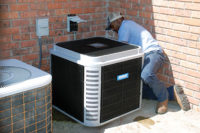Inverters are the hottest trend within the world of cooling systems. They’re energy-efficient for customers, allowing for better long-term service for a premium price tag. But many are used to the sales process for conventional HVAC systems. It can be difficult to start selling a brand system without a simple way to explain its functionality to homeowners.
Inverters can be explained most easily using a bell curve, which mirrors the average heat load throughout the day. It is coolest in the mornings and evenings and, obviously, warmest in the afternoon. This same bell curve can also be applied to the heat load throughout the year, especially in states with super-hot summers and cooler winters. My company happens to be located in Florida, which is pretty much hot year-round. But for those in different states, it can be extremely helpful to explain heat load on a micro scale (within a day) and a macro scale (within a calendar year).
The value brought forth by inverter air conditioners is pictured in green above. Inverters are built to work in accordance with the natural variance of temperature throughout the day. They constantly measure how much air and cooling they need to deliver in order to achieve an optimal temperature. This means that they work at a flexible rate, so they’re never overworking or underperforming. Further, these systems are excellent at regulating the humidity in the air. Overall — and this is what you should stress— inverters ensure comfort and energy savings.
Many homeowners are used to the sound of their systems turning on and off as they cycle. We’ve found that customers get excited by the consistency an inverter can offer. In other words, customers can expect a consistent temperature throughout the day, with no super warm moments right before their system kicks on to cool. This functionality also explains why inverters can help homeowners save money, as it takes less power (and energy) to run steadily as opposed to turning on and off throughout the day.
This is when you’re able to tie everything together as a comfort advisor. Most customers are frustrated by having to spend money on a new system, and it can be off-putting to promote a system more expensive than what they’re used to. However, inverters not only save homeowners money on energy bills, but they also save money long-term with its own lifespan. Because an inverter runs consistently, it doesn’t waste power cycling on and off, which can drastically impact the system’s lifespan. Instead of setting your customer up to replace his/her system within 10 years, you can promise them that an inverter will last much longer.
Inverters are the way to go if that homeowner wants to save money long-term while also increasing the comfort of their home.
Submit your own guest content here!











